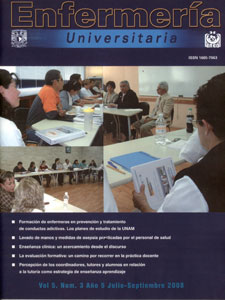Lavado de manos y medidas de precaución estándar practicadas por el personal de salud
Main Article Content
Abstract
Introduction: Within hospital environments direct contact i8s the most frequent infection transmission form; therefore, in order to reduce infections it is necessary to wash hands frequently and the follow the corresponding standard preventive measures. Objective: Observer the wash one’s hands frequency of use and the standard precautions in the health’s personnel. Methodology: This is a basic explorer transversal study based on a non probabilistic sample of 50 members from a D:F: Pediatric Hopspital. Used the Likert- scales instrument “Hand wash and standard preventive measures observation guide” and cleanliness practices were specifically assessed on those with close contact with patients. Results: It found that the frequency of hand washing lasting 20 seconds or more turned out to be only 4% . We also found that the health norm NOM-EM-002-SSA2- 2003was frequently underestimated. These situations place both the patients and the health staff at risk of infection. Discussion and conclusions: frequent hand washing while following the standard preventive measures protect both the patients and the health staff from infectious agents and thus must be the base of all therapeutics within hospitals.
Publication Facts
Reviewer profiles N/A
Author statements
- Academic society
- N/A
- Publisher
- Universidad Nacional Autónoma de México
Article Details
Dimensions citation
MÉTRICAS
Enfermería Universitaria by Universidad Nacional Autónoma de México it is distributed under the License Creative Commons Attribution - NonCommercial - NoDerivatives 4.0 International
Accepted and published articles become open-access under the terms of the Creative Commons CC BY-NC-ND 4.0 license, which authorizes the reproduction and sharing without commercial purposes, provided the corresponding acknowledgments to their authors. Authors are allowed to manage a self-archive copy of the article’s published version so that they can open-access it in their personal or institutional web pages, and/or any other broad-diffusion space.


